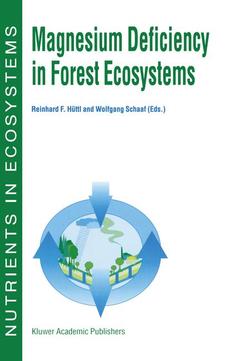Magnesium Deficiency in Forest Ecosystems, Softcover reprint of the original 1st ed. 1997 Nutrients in Ecosystems Series, Vol. 1
Langue : Anglais
Coordonnateurs : Hüttl Reinhard F., Schaaf Wolfgang W.

R. F. HUTTL AND W. SCHAAF Brandenburg Technical University Cottbus, Chair of Soil Protection and Recultivation, P.O. Box 10 13 44, 03013 Cottbus, Germany The health status of forest trees and stands is determined by numerous site factors such as chemical, physical, and biological soil factors, water supply, climate, weather conditions, management history as well as atmospheric deposition impacts. In this context, the nutrient supply is an important evaluation parameter. Forest trees well supplied with nutrients are more resistant to stresses that affect the forest ecosystem than other trees. This is true for both biotic and abiotic influences. Therefore the investigation of the so-called 'new type forest damage' was aimed at the exact determination of the health status of damaged trees. When considering the complete forest ecosystem, health (=vitality) means the sustainable ability to withstand negative environmental influences and still remain stable and productive. From this viewpoint, an optimal nutritional status is a prerequisite for an optimal health status. The term 'new type forest damage' comprises a number of damage symptoms which have been observed in various tree species on very different sites since the mid-1970s, particularly in Europe and North America. However, they occurred much more intensively in the 1980s. Generally, this forest damage was thought to be related to negative impacts of air pollutants.
1. Introduction; R.F. Hüttl, W. Schaaf. 2. Visual Mg-Deficiency Symptoms (Coniferous, Deciduous Trees) and Threshold Values (Foliar, Soil); P. Ende, F.H. Evers. 3. Temporal and Spatial Development of Mg Deficiency in Forest Stands in Europe, North America, New Zealand; G. Landmann, et al. 4.1 Biogeochemistry of Mg in Forest Ecosystems; K.H. Feger. 4.2. Tree Physiology; S. Slovik. 4.3. Influence of Magnesium Supply on Tree Growth; K. Makkonen-Spieker, H. Spiecker. 5. Causes of Magnesium Deficiency in Forest Ecosystems; K. Katzensteiner, G. Glatzel. 6.1 Soil Chemistry; S. Augustin, et al. 6.2. Tree Nutrition; M. Kaupenjohann. 6.3. Structural Aspects of Mg-Deficiency; S. Fink. 6.4. Fine Root Development; S. Raspe. 7. Evaluation of Different Mg Fertilization Strategies; W. Schaaf. 8. Concluding Remarks; R.F. Hüttl.
This book tries to summarize the knowledge of magnesium and its role in forest ecosystems gathered from recent studies as well as from historical experiences and findings. The results of these studies in most cases point to the activity of man and his influence on the ecosphere.
Date de parution : 10-2012
Ouvrage de 362 p.
16x24 cm
Disponible chez l'éditeur (délai d'approvisionnement : 15 jours).
Prix indicatif 52,74 €
Ajouter au panierThèmes de Magnesium Deficiency in Forest Ecosystems :
© 2024 LAVOISIER S.A.S.



